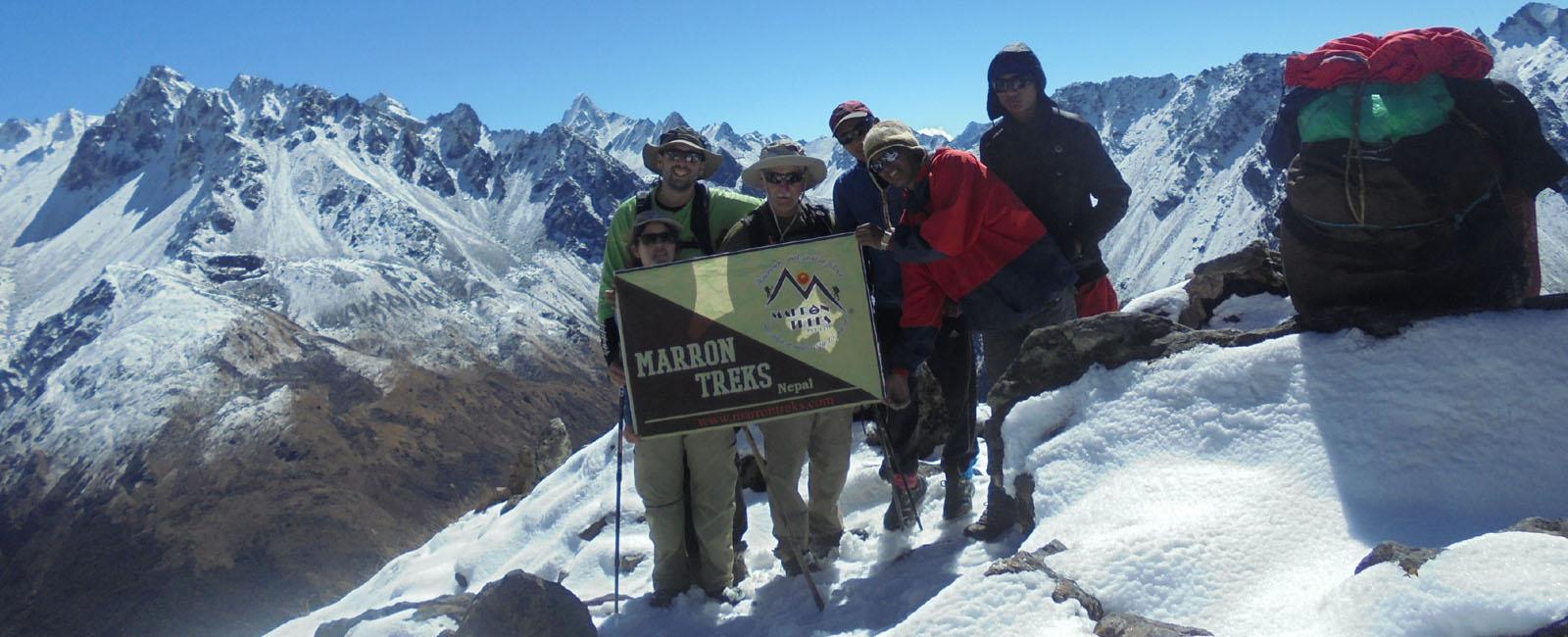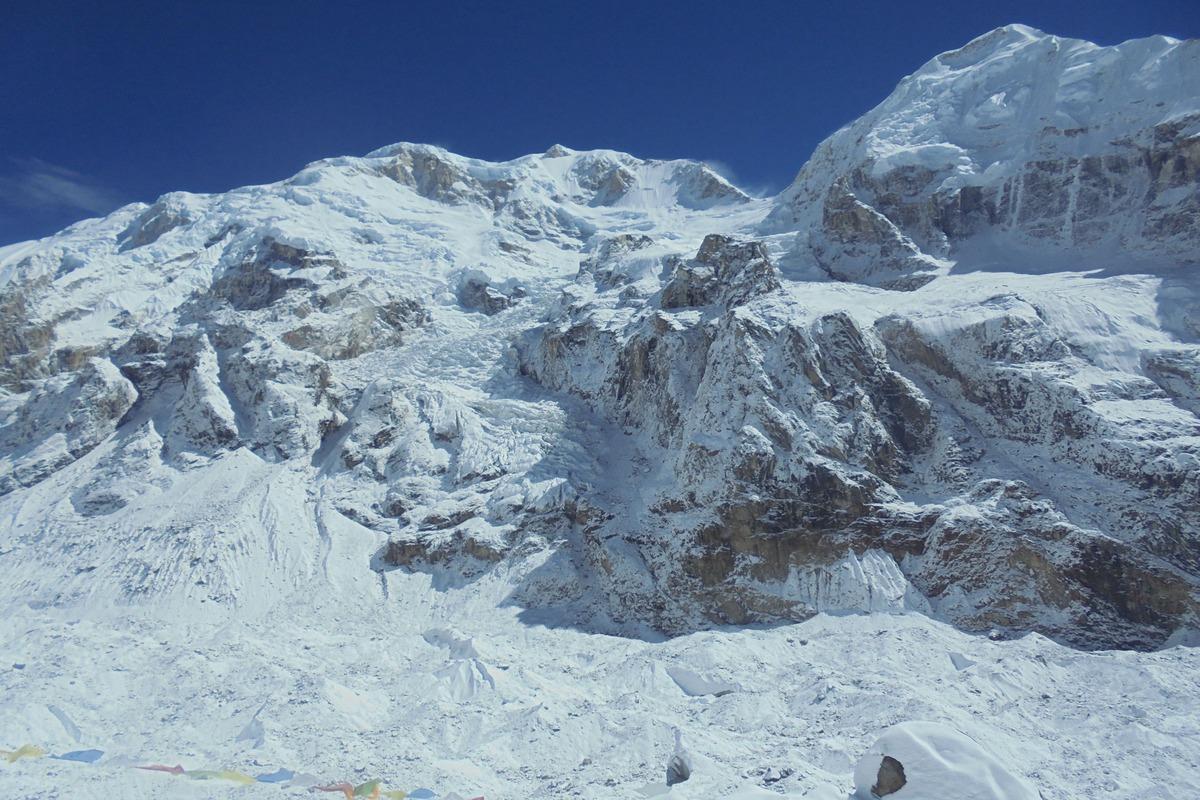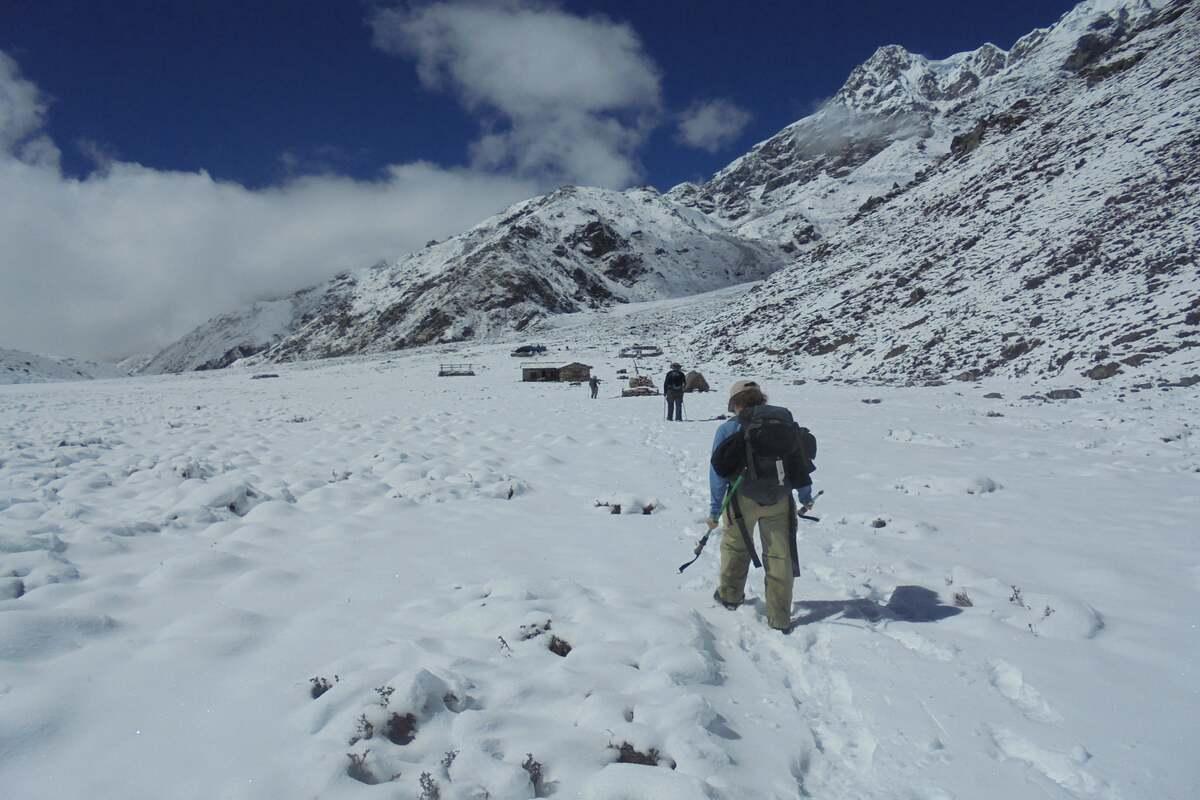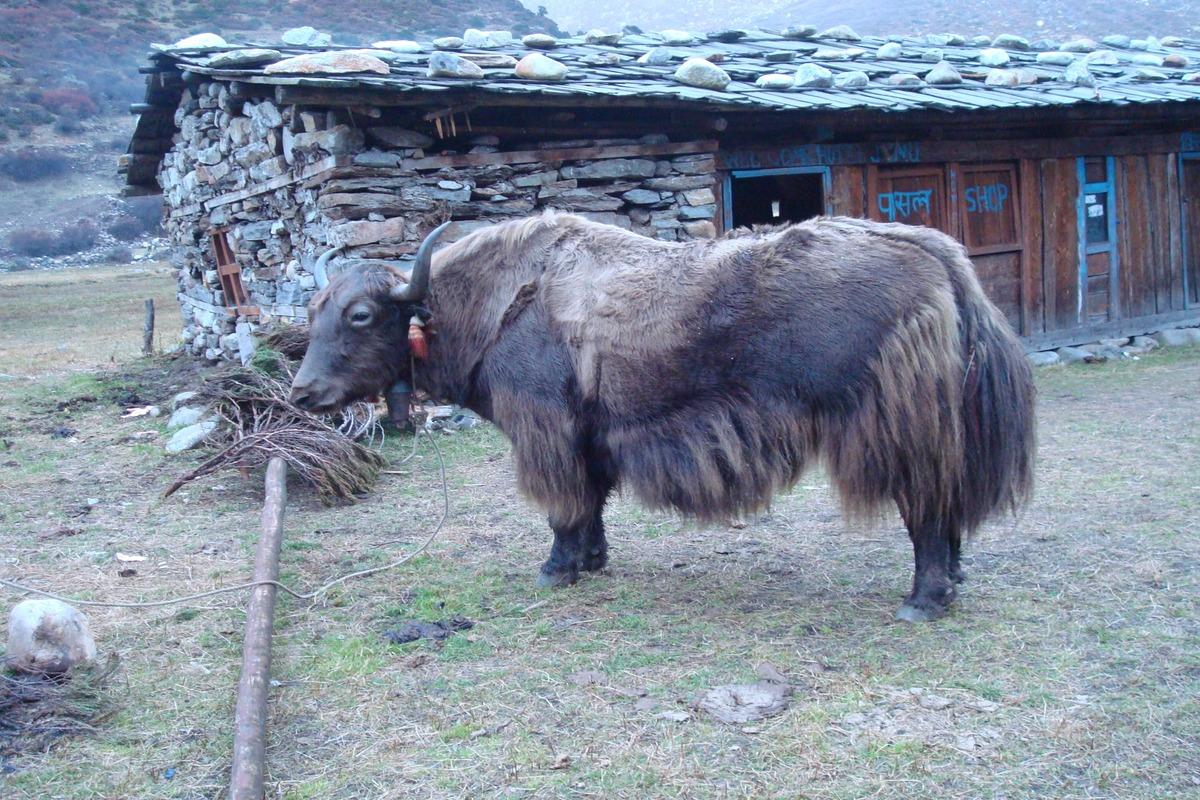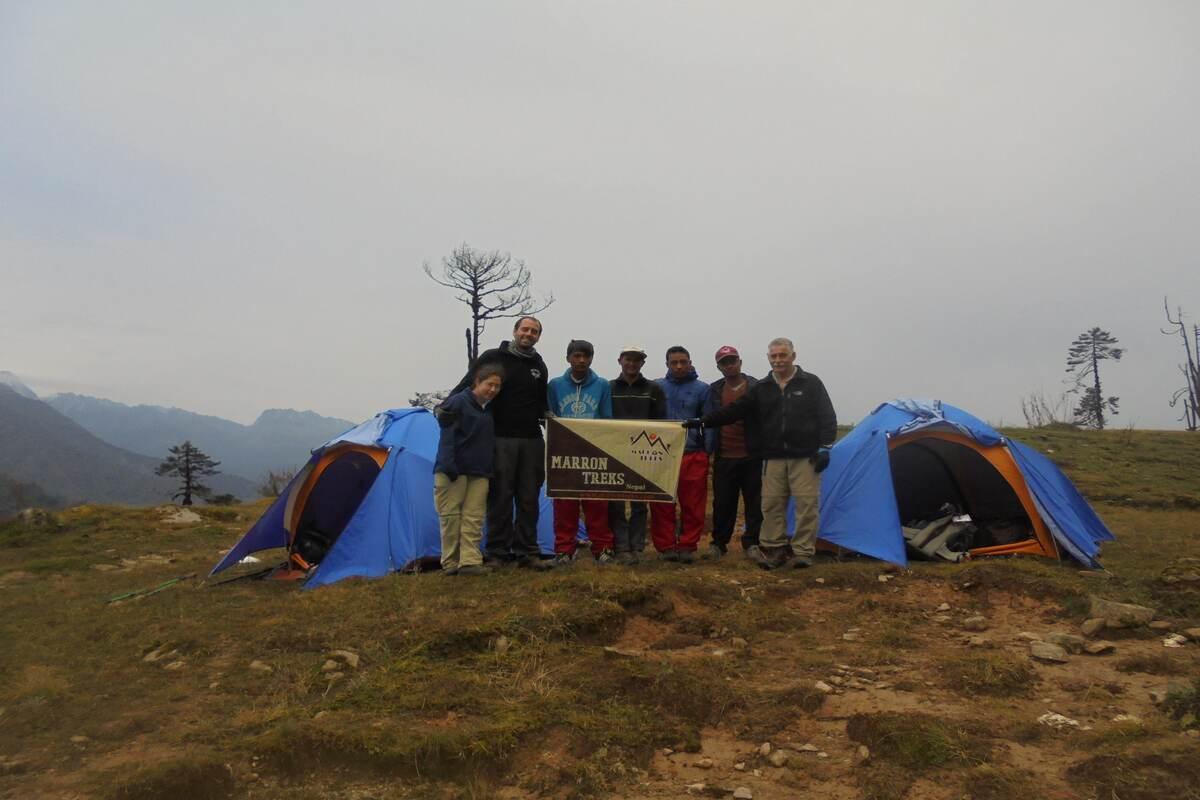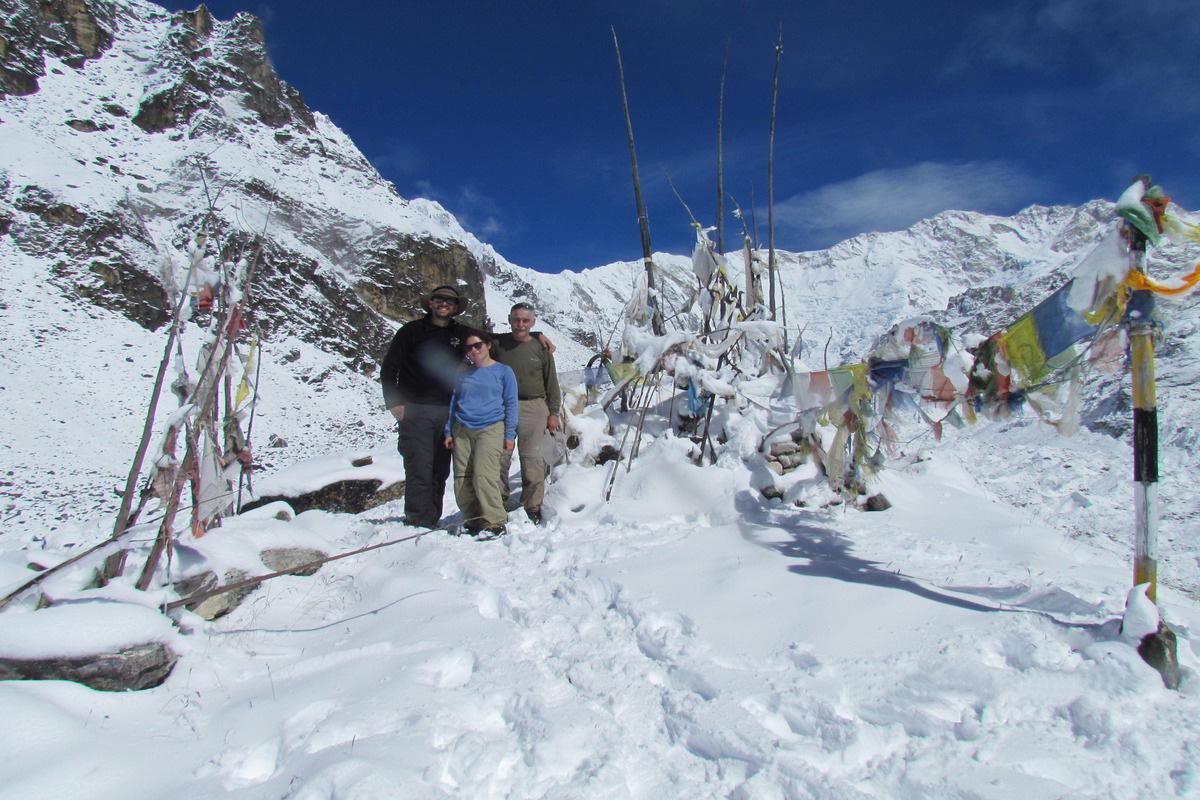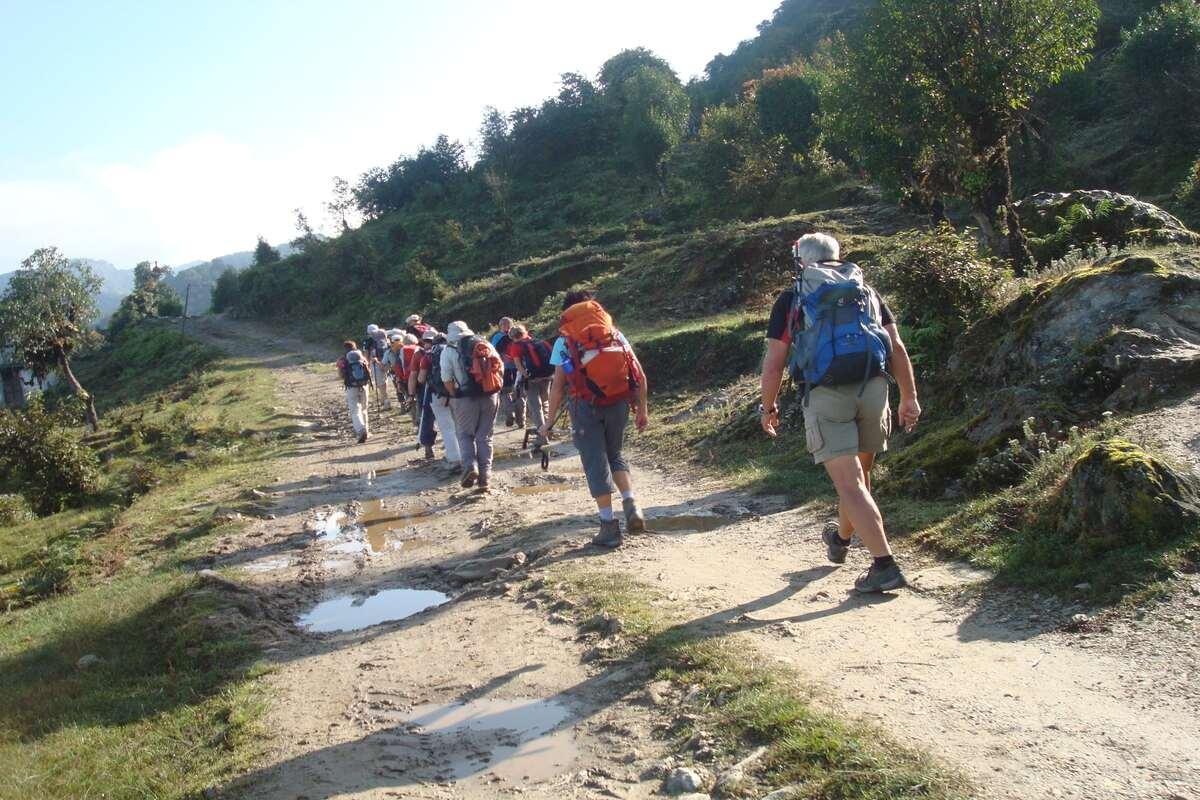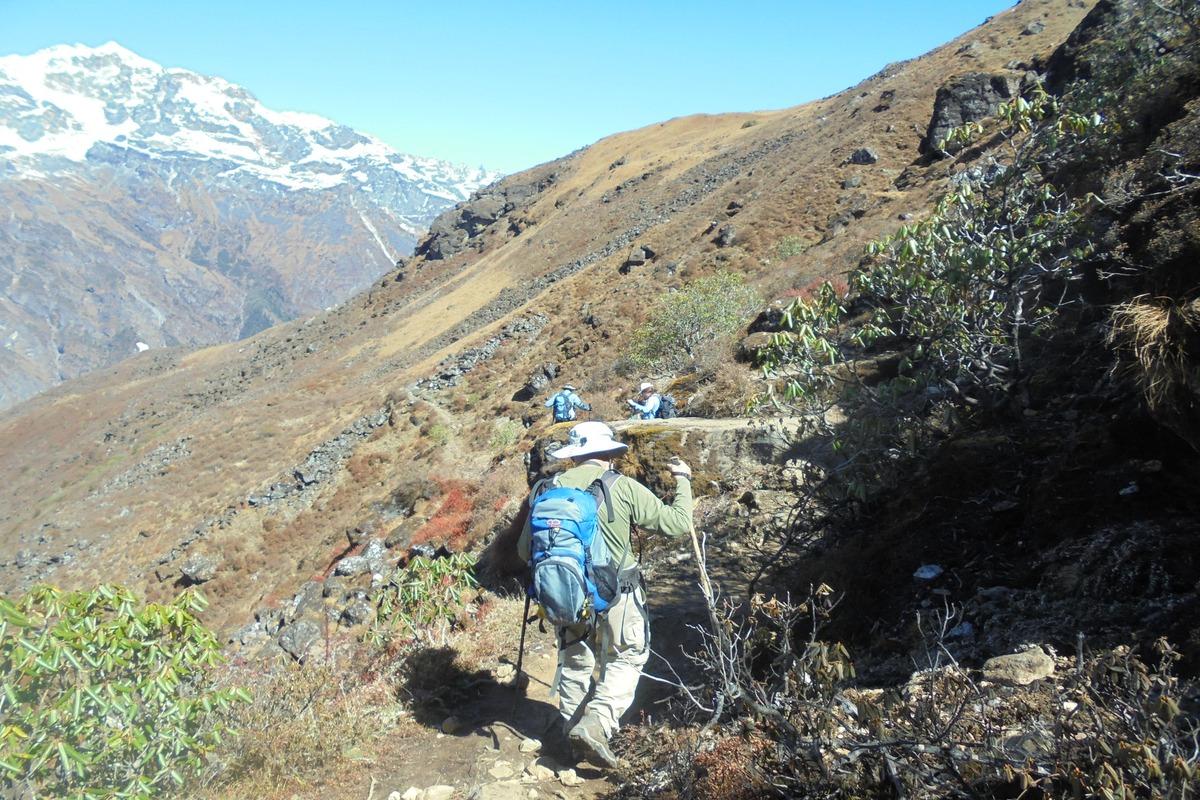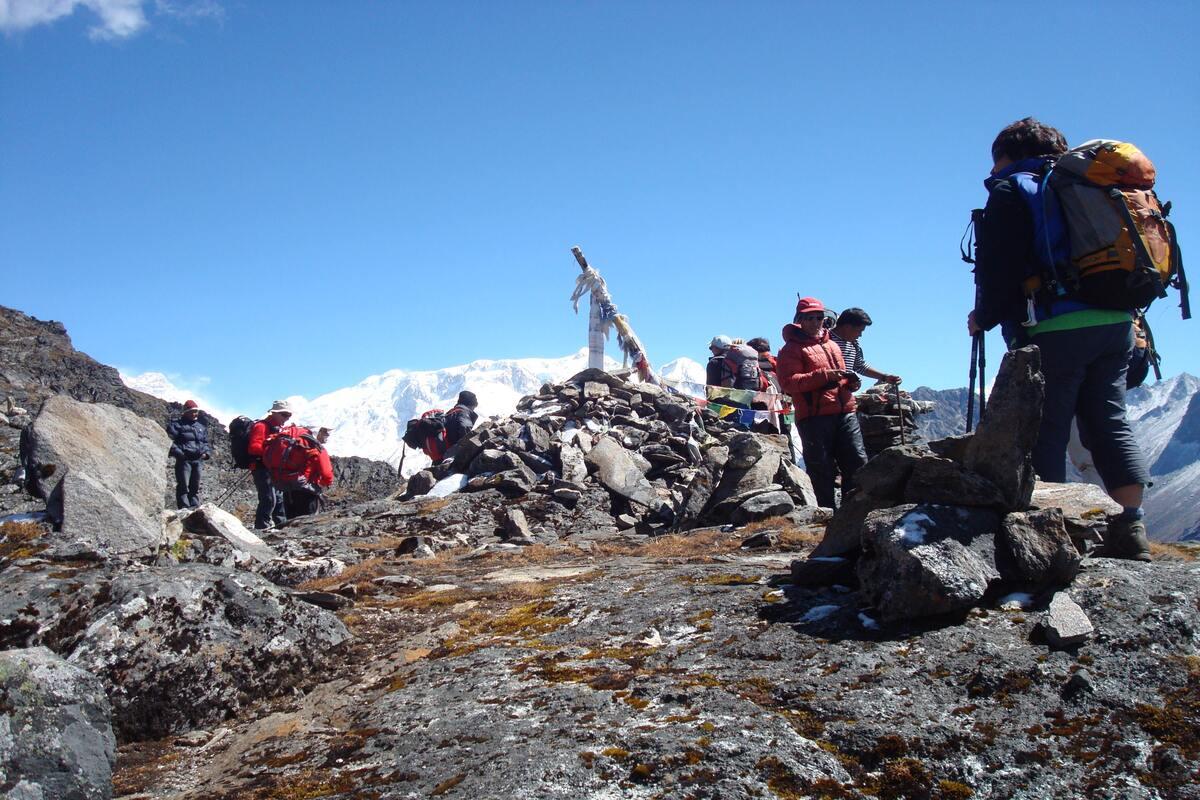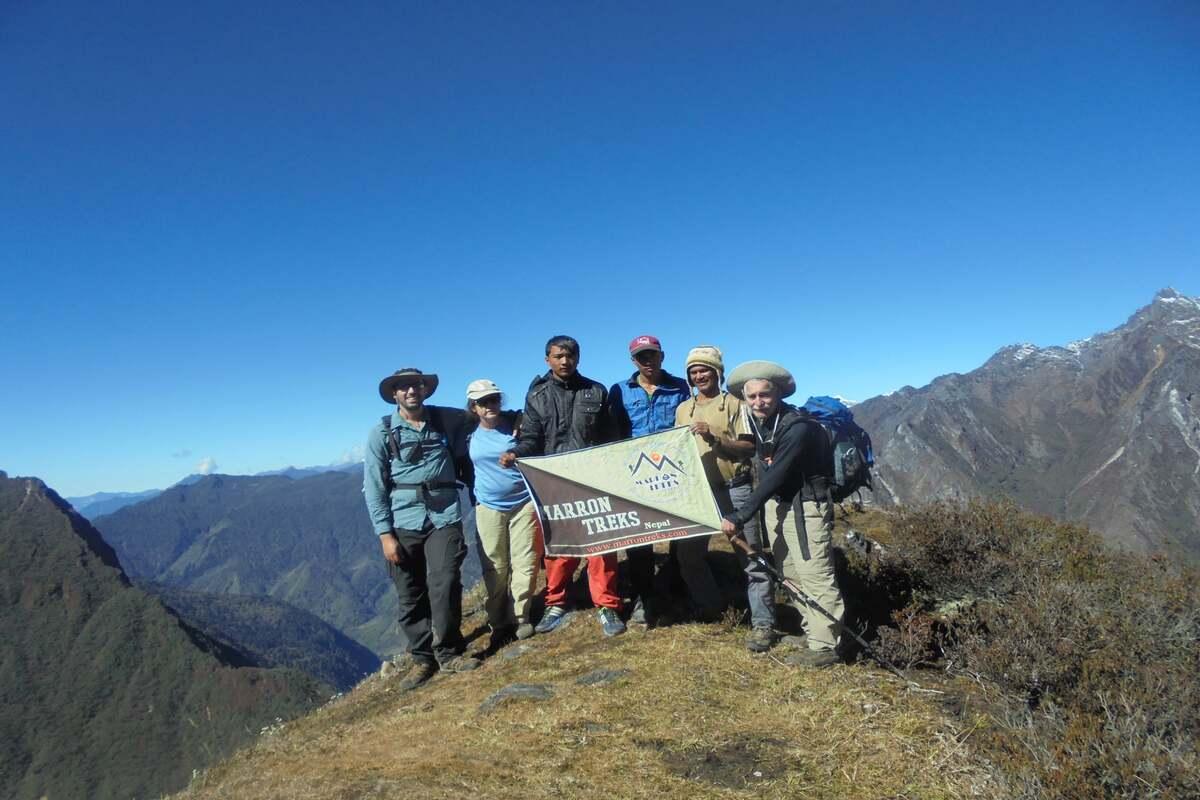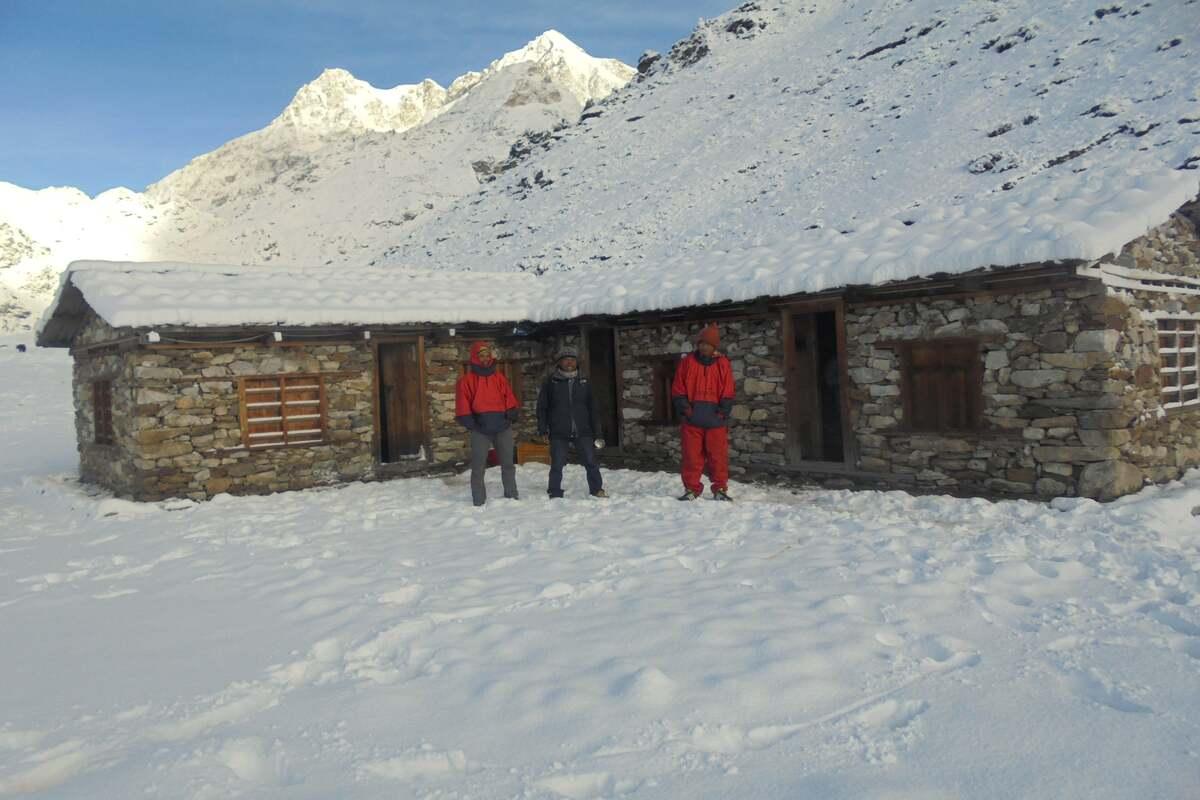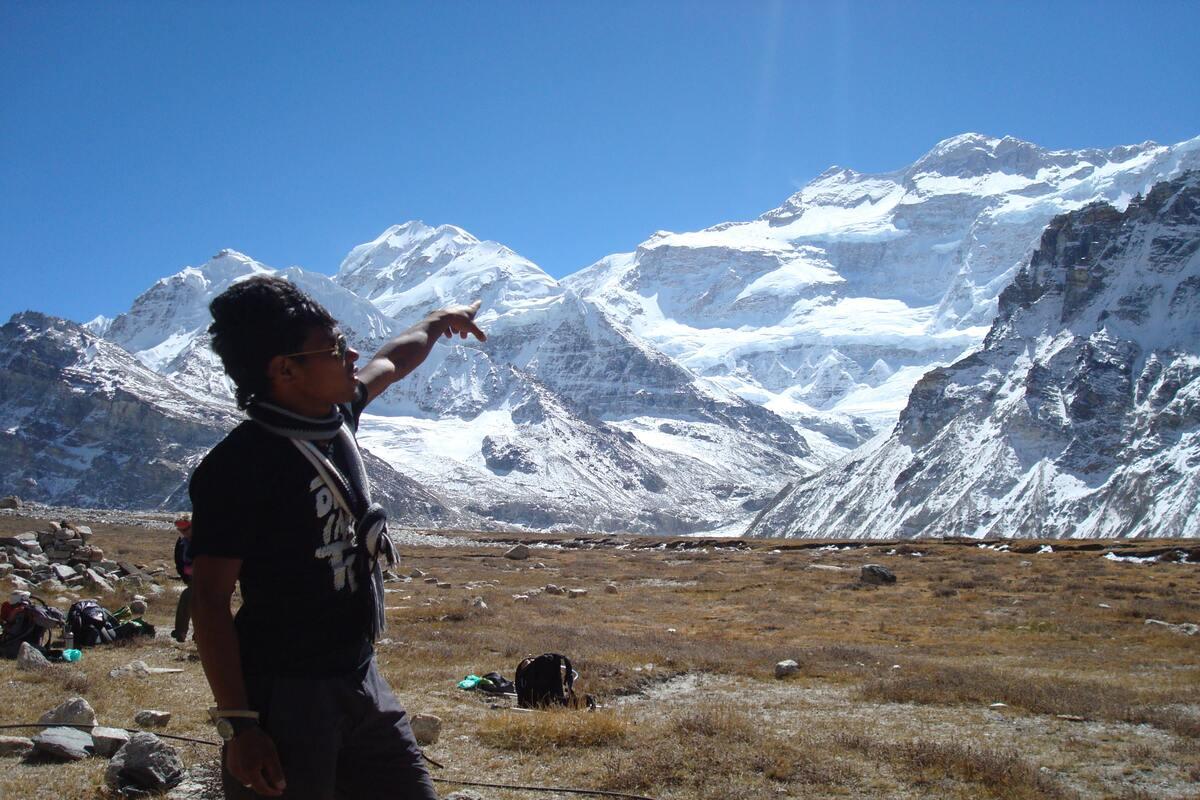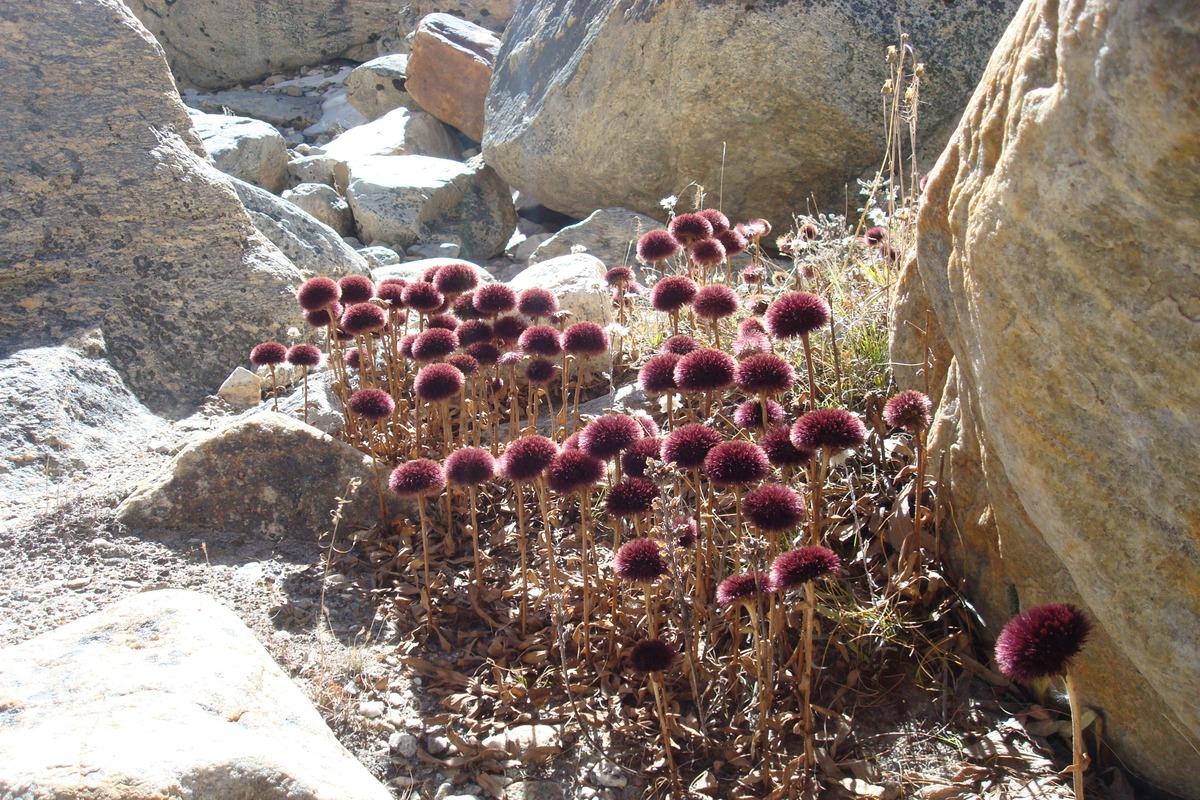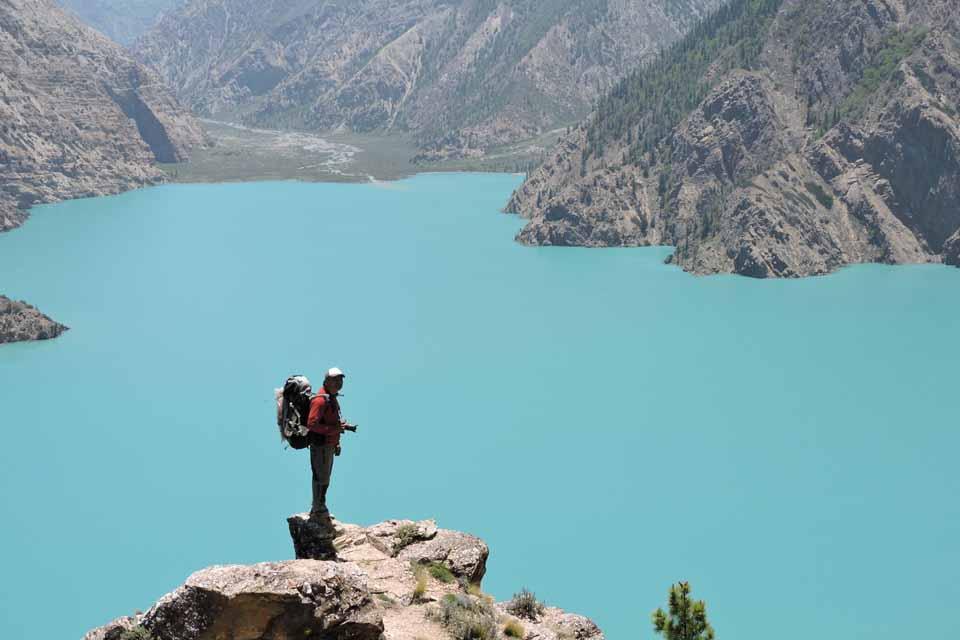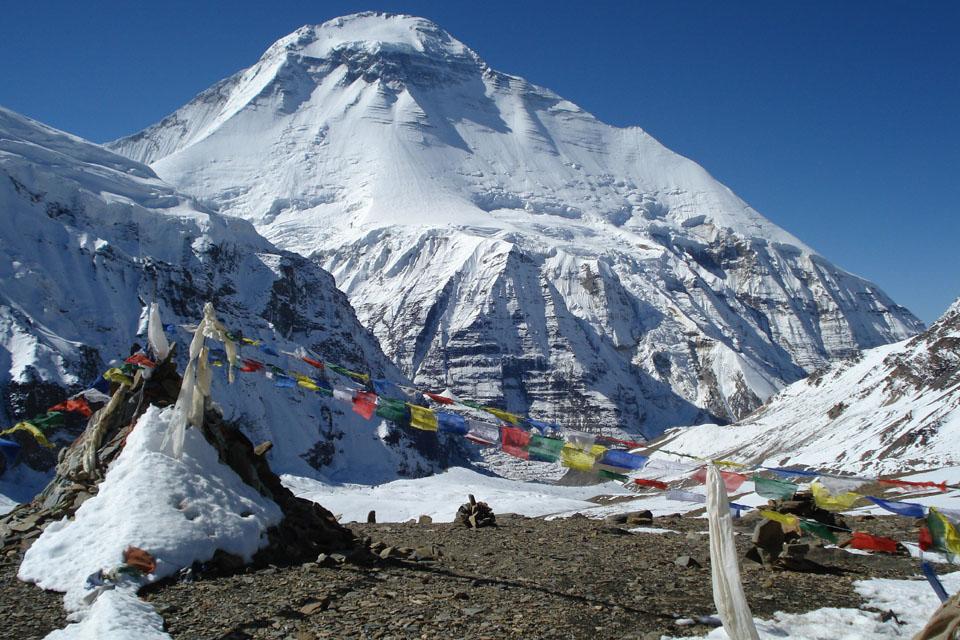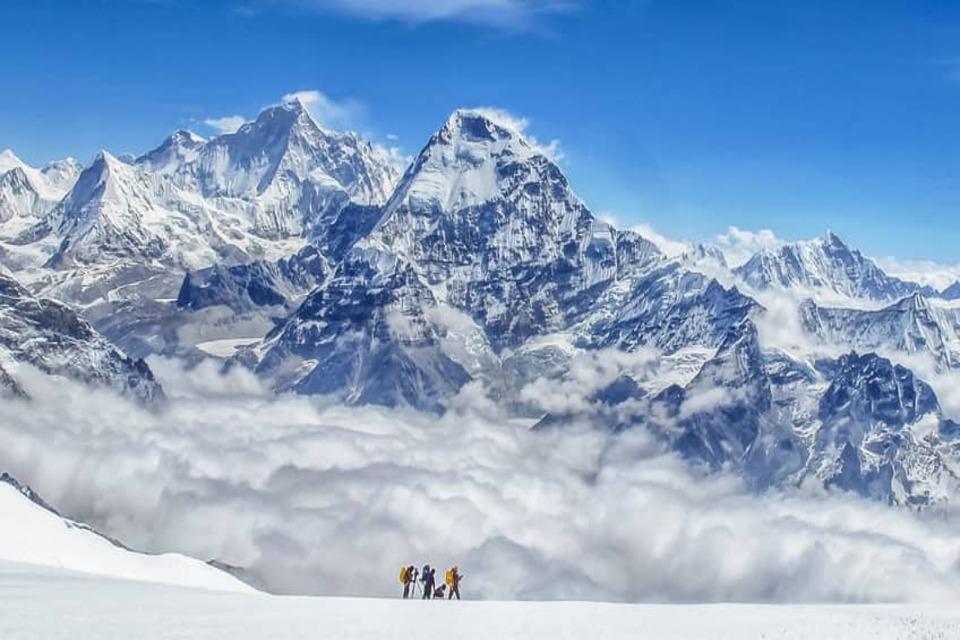Kanchenjunga Base Camp Trek
Trip at a Glance
Kanchenjunga Base Camp trek is a great Himalayan trail trek that leads to the foot of the third highest peak in the world, Mount Kanchenjunga. Mt. Kanchenjunga (8586m) is considered a sacred mountain to the locals situated in the eastern region of Nepal and bordered by Sikkim region of India.
The prime feature of the trek is to visit and explore Kanchenjunga Base Camp located at 5,100 meters from where one can witness the magnificence of the mountain itself including the surrounding peaks. Kanchenjunga base camp trek itinerary passes along several high passes, steep ascents, and descents so you need to be at your best in physical fitness and previous trekking experience is an added bonus.
As you will be walking through traditional villages you will have a nice overview of the local culture and traditions of the ethnic communities of the region specially the Limbu and Sherpa people.
Kanchenjunga Base Camp Trek Highlights
- Scenic flight: Kathmandu-Taplejung-Kathmandu.
- Explore Kanchenjunga Base Camp.
- Explore Yalung Ri Base Camp.
- Magnificent views of the Himalayan giants: Mt. Everest, Mt Makalu and Mt Kanchenjunga.
- Crossing Mirgin La Pass at 4,480 meters.
- Diverse flora and fauna and rich local culture.
Itinerary
Day 01: Arrive in Kathmandu (1400m)
Day 02: Fly from Kathmandu to Suketar (2320 m/35 min) & trek to Lali Kharka (2,276 m/3.5 hrs)
Day 03: Trek from Lali Kharka to Khesewa (2,120 m/5 hrs)
Day 04: Trek from Khesewa to Mamankhe (1,920 m/5 hrs)
Day 05: Trek from Mamankhe to Yamphudin (2,080 m/6 hrs)
Day 06: Trek from Yamphudin to Chitre (2,965 m/5 hrs)
Day 07: Trek from Chitre to Tortongn (3,010 m/6 hrs)
Day 08: Trek from Tortongn to Tseram (3,870 m/6 hrs)
Day 09: Trek from Tseram to Ramche (4,580 m/4 hrs)
Day 10: Explore around Ramche (4,580 m) & trek to Oktang (4,730 m/5 hrs)
Day 11: Trek from Oktang to Yalung Ri Base Camp (5,400 m/5 hrs)
Day 12: Trek from Yalung Ri Base Camp to Ramche (4,580 m/5 hrs)
Day 13: Trek from Ramche to Sallerle via Mirgin La (4,480 m/6 hrs)
Day 14: Trek from Sallerle to Ghunsa (3,475 m/5 hrs)
Day 15: Trek from Ghunsa to Kambachen (4,040 m/6 hrs)
Day 16: Exploration Day at Kambachen (4,040 m)
Day 17: Trek from Kambachen to Lhonak (4,790 m/6 hrs)
Day 18: Trek from Lhonak to Pang Pema (5,140 m/4 hrs)
Day 19: Explore around Kanchenjunga Base Camp (5,100 m) & return to Kambachen (4,040 m/5hrs)
Day 20: Trek from Kambachen to Ghunsa (3,475 m/6 hrs)
Day 21: Trek from Ghunsa to Amjilosa (2,460 m/4 hrs)
Day 22: Trek from Amjilosa to Sakathum (1,600 m/5 hrs)
Day 23: Trek from Sakathum to Chhiruwa (1,200 m/5 hrs)
Day 24: Trek from Chhiruwa to Suketar (2,420 m/5 hrs)
Day 25: Fly from Suketar to Kathmandu (1400m/30 min)
Day 26: Free day in Kathmandu (1400m)
Day 27: Final Departure
Upon arrival at the Tribhuwan International Airport in Kathmandu, you need to accomplish your entry/visa formalities. You will then be received by a representative from Marron Treks and transferred to your hotel in Kathmandu. Welcome drinks will be served at the hotel and then we will have a quick pre-trip meeting. You can then spend the remaining time resting or as you please. In the evening you can stroll around the vicinity of your hotel just to get the feel of this wonderful city.
Fly from Kathmandu to Taplejung at Suketar Airport in Taplejung which is about 35 minutes flight where you will meet your trekking team. After lunch start the trek in the afternoon with an easy 2- to 3-hour walk along the ridgeline to Lali Kharka, a grazing area.
The trail traverse along the hillside a short way it descends to Pakora village along the Phawa Khola, crossing a suspension bridge before beginning the steep climb up towards Kunjuri. Lunch will be somewhere below Kunjuri. After lunch it’s a short distance walk over the crest of the ridge to our campsite at Khesewa. Get your first view of Mt. Kanchenjunga and should be able to clearly make out the south and main summit along with Yalung Kang.
You will go along a steep hillside through terraced fields high above the Kabbeli Khola. There are some ups and downs crossing side valleys but there are many shady spots to rest. Then after lunch cross the village of Anpan, before descending to cross the Kashawa Khola. After climbing again through terraced fields will reach the village of Mamankhe.
Today you need to start early as the day involves an easy climb to Yamphudin along a track which contours the hillside above the Kabeli Khola. You will go through several ups and downs while crossing the ridges and stream beds that make up the valley sides. Generally, the route is flat and the river eventually becomes level with the trail, a couple of hours before Yamphudin. You can stop for a bath at one of the clear pools within this beautiful river.
Get your lunch by the side of the river and walk to Yamphudin the most remote settlement in this area and the last village we will see until we reach Ghunsa. It is a charming place tucked away beneath the ridge of Deurali Danda that we cross next.
You will ascend a steep spur, a gentle introduction for what will come. Leaving behind villages the trail passes through pleasant forest, stopping for lunch in a meadow capturing fine views of the north and south. You will then steeply descend to the river through an interesting bridge across the Omje Khola to reach our campsite in Chitre.
The day begins with 3 hours of steep ascent to the crest of the Deurali Danda in dense forest most of the way. From the 3,230 m pass we see Jannu, definitely closer! The trail then descends across some steep and exposed areas before entering the forest again. You will have to then sharp descent through beautiful forest contiuing down into the valley of the Simjua Khola. After crossing an interesting-looking and challenging wooden bridge will reach Tortongn, the camping site with numerous rock shelters amid towering conifers.
The trial follows the river through a more beautiful forest, the conifers giving way to the rhododendron forest. You will climb a fairly steep valley with the trees becoming more stunted and scattered, giving us glimpses of the snow-capped peaks ahead and the massive snout of Yalung Glacier. Before reaching Tseram the towering heights of Kabru and Rathong peak start to peep over the moraine. Tseram is a grazing area and night temperatures will remind us that we are really gaining height.
Today is a shorter day’s walk up the final 600m to Ramche where the trail to Kanchenjunga South turns dangerous. As you ascend past the snout of Yalung Glaciers into a series of ablation valleys, the scenery becomes magnificent with the walking become easy. En route you will witness a frozen lake, clear streams and views of Koktang, Rathong and Kabru.
You will get your first encounter of Mt. Kanchenjunga. Follow the valley round to observe the stunning south face of Kanchenjunga and Jannu. Cross the the Yalung Ri Glacier and continue by a sweeping curve, at Oktang, 4,730 m, suddenly we are confronted with the southern wall of the mountain. This vast ridge forms a cirque over 15 kms long, nowhere less than 7,500 m high and with three main summits of Kanchenjunga at 8,420 m, 8,586m, and 8,474 m. The mountain panorama is spectacular and especially impressive is Jannu while observing the glaciers flowing from its east face.
You will go to high altitudes today which requires a strong determination. A good weather is required to cross the high passes and of course perfect logistic support. Expect to get acclimatized with the altitude today.
You will have a good walk at Yalung Glaciers and a series of valleys and perfect spot for camping. You will encounter a frozen lake, clear streams and magnificent views today.
The trail goes down the valley passing the turn off to the high and challenging Labsang La route to Ghunsa and the north side of Kanchenjunga. This pass is rough and dangerous, especially for porters so we take the more southern set of passes, beginning with the Mirgin La. You will go through steep climb and several false summits will reach Mirgin La. Views seen apart from the magnificent Jannu on the horizon are Makalu, Gyakung Kang, Everest, Lhotse and Chamalang. You can see Terai plains to the south. The camping is beyond the pass, after 6 to 7 hours tough walking.
There is little descent between four passes today but is a high scenic area. After lunch you will descent to Lamba Sumba Kharka, where there are more views of the awesome Southwest Face of Jannu. After Kharka it’a easy going down a pleasant forested trail to the village of Ghunsa where campsite is located.
Ghunsa is a picturesque Tibetan village where prayer flags flutter from the wooden houses. There are two monasteries in Ghunsa which is a welcome sight after the many days of wilderness. One of the local specialties’ is ‘Tongba’, a curious alcoholic drink. A jug or large bamboo cup is filled with fermented millet seed and boiling water pored over. The flavour and alcohol seep though and you drink it with a special straw. You might need a drink after the tough 4- to 6-hour walk
The trail Gradually ascends to south of the Ghunsa Khola and crosses flood plains while emerging on a pasture situated at the north side of the river. You will then have to climb steeply to a slope slope from where it crosses a slide and then descends to Lakepo. A short climb from here will reach the village of Kambachen.
Today is an acclimatization day to cope with the high altitude. The day can be used for a short morning hike to explore the area around Kambachen. . It is essential to acclimatize to the higher altitude as you have been spending a lot of time at lower altitudes. From Kambachen you have a good views of the peaks near Kanchenjunga. You can hike up the ridge above the village for better views or take a day hike to Jannu Base Camp. Kumbakarna is the Nepali name of Jannu.
The trail climbs gradually through rocky fields to Ramtang (4,240 m) then crosses the northwest of the Kanchenjunga Glacier to reach Lhonak, which is on a sandy plain near a dry lakebed. You will camp between the boulders here to stay out of the wind. A beautiful mountain vistas can be observed all around. Water is very scarce in Lhonak and you will need to use only as much as absolutely necessary.
Pang Pema provides the view of the main Kanchenjunga peak. Pang Pema is is the base camp for expeditions on Kanchenjunga. From Lhonak you will gradually ascend across the plain but soon you will have to steeply climb, following the moraine.
You will go for a of 200 m or 300 m on a morning hike up a ridge, north of Pang Pema. It’s a good vantage point with views of Kanchenjunga, Wedge Peak, the Twins and Tent Peak. As usual, the descent goes faster and you can reach Kambachen the same day.
The trails is more descents today thru magnificent sections of forest as long as we make Amjilosa tomorrow. After an hour’s walk from Ghunsa you will through Phole, a village in two parts. The upper section houses Tibetan refugees who are well established, the second is the winter village of Ghunsa. Further down is Yangswa, a great and warm camp.
First the trail passes thru the beautiful forest opening out to steep, grassy hillsides where Amjilosa is perched.
You will go for a of 200 m or 300 m on a morning hike up a ridge, north of Pang Pema. It’s a good vantage point with views of Kanchenjunga, Wedge Peak, the Twins and Tent Peak. As usual, the descent goes faster and you can reach Kambachen the same day.
The trail crosses the Simbu Khola, which originates from Kanchenjunga’s south base camp, the river which we followed up from Torontan. It is pleasantly warm at these low altitudes and cardamom grows freely in the moist shaded forest. You will cross numerous small tributary streams to reach Chhirwa, a village set among large boulders. You camp in a field out of the village. Today is an easier day.
The trail goes in and out of minor valleys passing thru a succession of picturesque villages and reach Suketar around late afternoon.
After an adventurous trek in the Himalayas you will fly back to Kathmandu today.
This is a free day in Kathmandu to fulfill anything that you missed out spotting in this energetic capital of Nepal. You can indulge yourself in shopping or strolling around some of the cultural and historical landmarks of Kathmandu. Thamel is your hot spot for shopping where you can haul all the souvenirs representing Nepal and its culture. May be that in addition to your interesting trip anecdotes, you would also want to take back some stuff for your friends and relatives. In the evening, a farewell dinner with a range of traditional Nepali cuisines, will be hosted by Marron Treks. Enjoy the dinner, pack/prepare yourself for a flight back home and have a beauty sleep.
The trip concludes and our office representatives will take you to the international airport in Kathmandu to catch your onward flight to your next destination or fly back home. You need to be at least 3 hours prior to your flight time at the airport.
Thank you for visiting Nepal and we hope your Himalayan Holiday has come true. Have a safe flight back home!
If you plan to extend your holiday then other travel activities like jungle safari, rafting, mountain biking, bungee jumping etc are also up on the list.
What is included?
- Airport pick-up and drop services.
- Hotel accommodation in Kathmandu with breakfast.
- Kathmandu/Suketar/Kathmandu airfares.
- All trekking accommodation (in tented camps) with breakfast, lunch & dinner.
- Four seasonal sleeping bags (to be returned after trip completion) & Marron Treks duffel bags.
- A comprehensive medical kit ( will be carried by the trekking guide)
- Guide, porters, kitchen staff and helpers' wages for the trekking period.
- Personal insurance for crew members.
- Kanchenjunga area special permits, Kanchenjunga conservation entry fee & Trekkers’ Information Management System Card.
- Farewell dinner with a live Nepalese cultural program.
- All government and local taxes.
What is not included?
- International airfare.
- Nepal entry visa fee – Visa can be obtained upon your arrival at the Tribhuwan International Airport in Kathmandu. (USD50 for 30 days)
- Lunch & dinner in Kathmandu
- Personal travel insurance.
- Emergency rescue evacuation (to be covered by the client's travel insurance).
- Excess baggage charges (luggage allowance for domestic airlines in Nepal is 15 kgs.)
- Other expenses of a personal l nature (phone calls, laundry, battery recharge, extra porters, bottle or boiled water, shower etc.)
- Cost incurred due to the addition of extra days or change in the itinerary due to bad weather, political turmoil or any other unforeseen contingencies.
- Bar bills, alcoholic drinks & beverages.
- Tips to guide & porters (Tipping is expected).
Route Map
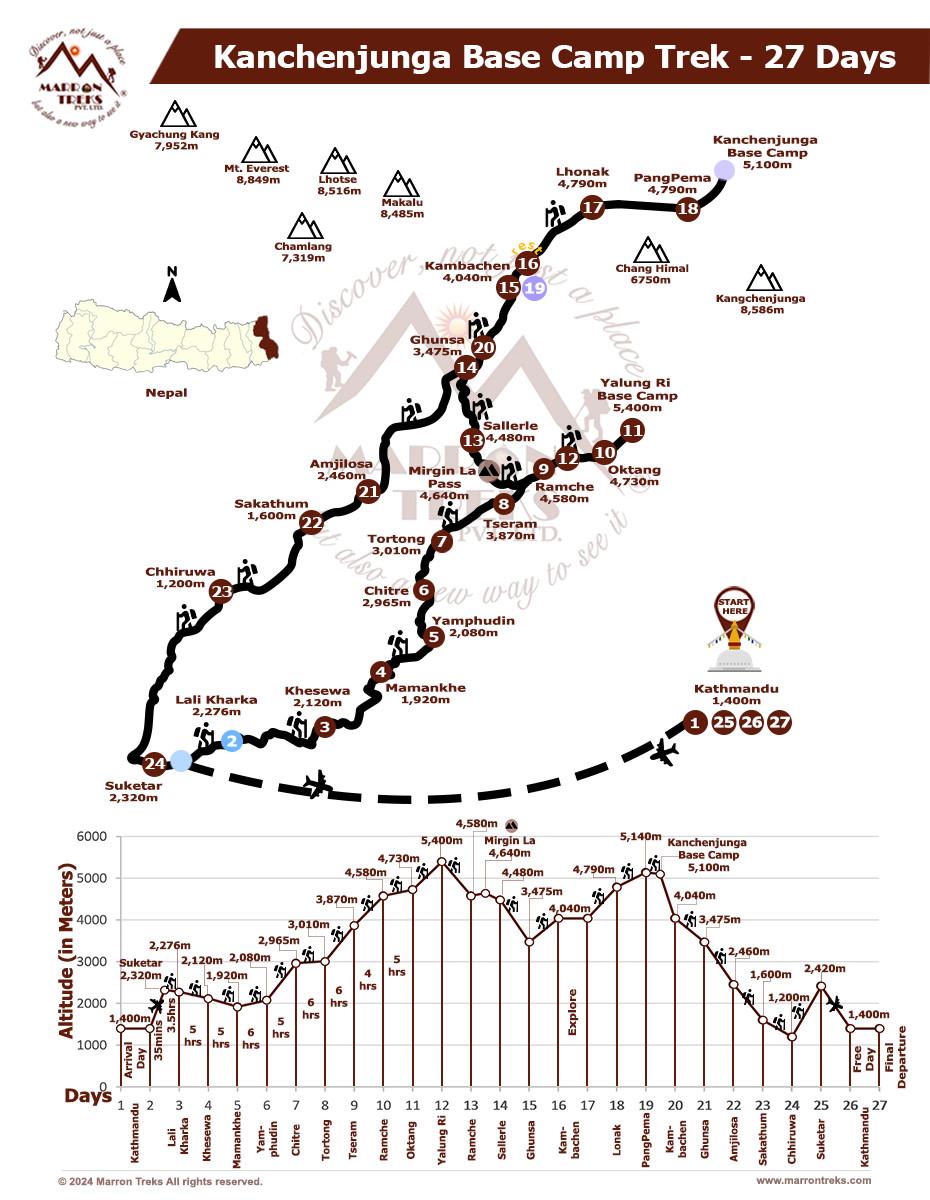
Trip Info
Accommodation
While you are in Kathmandu, we opt to accommodate you in 4- or 5-star hotels like Hotel Royal Singhi (4-star), Hotel Manaslu (4-star), Radisson (5-star), Yak & Yeti (5-star), or similar. During the trek, your primary accommodation will be tents. These are typically high-altitude, double-walled tents for better insulation and weather protection. You'll camp in designated campsites along the route. These are chosen for scenic beauty, flat ground, and access to water sources. Your trekking crew will set up tents that include your own personal tent, dining tent, toilet tent and staff tent.
Meals
We never compromise the quality of food or the health of the trekkers as well as the crew members. Expect meals packed with carbohydrates and protein prepared by our trained cook to provide sustained energy for long trekking days. Think along the lines of porridge, pasta, noodles, spaghetti, French fries, soups, and dehydrated meals.
Acclimatization
Altitude sickness is a serious risk while trekking in the Himalayas. It's important to acclimatize properly by spending a few days at lower altitudes before heading higher. By spending time at lower altitudes before pushing higher, your body has time to adjust. Our trekking packages have enough acclimatization days planned where you'll be spending a day or two at lower altitudes, allowing your body to adjust to the increasing altitude.
Drinking water
You can fill your bottle with boiling water. To make water drinkable, you can use water purification tablets too. But, due to hygienic issues, you should avoid drinking water from taps, rivers, or wells in trekking areas.
Communication
Our office in Kathmandu is in constant communication with your trek guide. In Kathmandu, you can purchase a local sim card for communication purposes. At high elevations, the mobile signal might not be as strong, though.
Luggage
Our porters are paired with one trekker for every two hikers, and one porter can safely carry 30 kg maximum weight. Therefore, we advise you to fill your duffle bag not more than 15 kg with your belongings. You may carry a small backpack with your valuables and informational documents. The things you are not taking along on the trek can be stored in a hotel in Kathmandu free of cost.
Typical Trek Day
Mostly your trek day starts with breakfast at 7-8 am, followed by a 3-4 hour morning trek. Lunch break is around an hour, then you continue trekking to your destination for the day. After reaching the teahouse lodge, you can relax, explore nearby areas, and enjoy dinner at 6-7 pm. Evenings involve socializing, a trek briefing, and leisure activities before bed.
Travel Insurance
It is advised that you arrange your travel insurance before leaving your homeland. The main thing is to make sure that your insurance covers you for both- medical and evacuation costs. Having travel insurance with you makes your trip secure and hassle-free.
Our Guides
Guides play a significant role during the trek. They are the ones who literally decipher the trekking codes for you so that you can actually connect with nature, culture and people along the way. We have helpful and dedicated trekking guides who are very well-versed in the culture, life patterns and every single detail pertaining to the trek region you are traveling in. Thus, in the company of our professional Sherpa guides, your trek becomes not only entertaining but also equally informative.
Porter and Staff Care
When it comes to high-altitude trekking, porters and staff members make up a pivot. Marron Treks ensures that all the porters and staff members going to high altitudes are provided with adequate clothing and equipment. All our field staff are covered by insurance.

